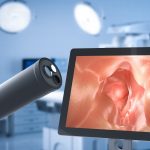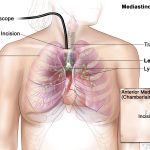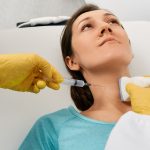Cancer can sometimes spread into the lymph nodes under the arm (axilla). This can happen with different types of cancer, including breast cancer.
To check the lymph nodes under your arm for breast cancer cells, you have an ultrasound scan.
Ultrasound scans use high frequency sound waves to create a picture of a part of the body. The ultrasound scanner has a microphone that gives off sound waves. The sound waves bounce off the organs inside your body and are picked up by the microphone. The microphone links to a computer and turns the sound waves into a picture.
If doctors find any abnormal areas, they use the ultrasound to guide a needle and take a sample of cells. This is a biopsy.
You may hear this test being called axilla lymph node ultrasound and biopsy.
What are lymph nodes?
There is a network of lymph nodes close to the breast. They are part of the lymphatic system  that runs throughout the body.
that runs throughout the body.
Breast cancer cells can sometimes break away from the breast tissue and go to the nearby lymph nodes under the arm.
The diagram below shows the network of lymph glands around the breast and armpit
Preparing
You’ll be given written instructions on how to prepare for your axilla lymph node ultrasound and biopsy. You should be able to eat and drink normally beforehand.
Take your usual medicines as normal unless your doctor tells you otherwise. If you take warfarin or other medicines to thin your blood, you need to stop this before your test. Your doctor will tell you when to stop them.
What happens during the lymph node ultrasound scan
You usually have this test in the x-ray department. Or you may have it alongside other tests, such as a mammogram in a one stop breast clinic.
Your doctor or nurse will give you information about the test and ask you to sign a consent form. This is a good time to ask any questions that you have
When you are in the ultrasound room, a staff member will ask you to take off your upper clothing. You usually put on a hospital gown. You lie down on the scanner couch and put your arm above your head.
A specialist doctor called a radiologist does the scan. They put a gel over your underarm area and hold an ultrasound probe on your skin. They move the probe over the skin.
You might feel a little pressure when they move the probe. It shouldn’t hurt. Tell them if it is uncomfortable for you.
If your doctor sees any changes in the lymph nodes on the ultrasound, they might take a biopsy.
What happens during the lymph node biopsy
First, your doctor cleans the skin. They then use a local anaesthetic  to numb the area. This might sting a little.
to numb the area. This might sting a little.
When the area is numb, they put a thin, hollow needle attached to a syringe through your skin. Then they take a sample of cells. They might take samples from more than one area.
You will feel some pressure on the armpit, and it can sometimes feel uncomfortable, but it isn’t usually painful. Do let the doctor know if it is painful, you may need more local anaesthetic.
Your doctor removes the needle once the sample is taken. They put pressure on your armpit for a few minutes after the test. This is to prevent bleeding and bruising.
After the lymph node ultrasound and biopsy
You should be able to go home soon afterwards.
You will have a small dressing over the biopsy area. Your doctor or nurse will tell you how to look after this for the next few days.
Getting your results
You should get your results within 1 or 2 weeks at a follow up appointment.
Waiting for test results can be a very worrying time. You might have contact details for a specialist nurse who you can contact for information if you need to. It can help to talk to a close friend or relative about how you feel.
What will happen following my results?
Your doctor might suggest surgery to remove all or most of the lymph nodes in your armpit if the results show that you have cancer cells in the lymph nodes. You have this at the same time as your breast cancer surgery or as a second operation. This is called an axillary lymph node dissection or clearance.
If the lymph nodes look normal, you may have a sentinel lymph node biopsy during your breast surgery. This is to make sure that cancer has not spread to the sentinel lymph node. The sentinel node is the first node fluid drains from the breast into the armpit.
Your doctor will explain the results and tell you what treatment you need.
Possible risks
A lymph node biopsy is a safe procedure but your nurse will tell you who to contact if you have any problems afterwards. Your doctors will make sure the benefits of having a lymph node biopsy outweigh these possible risks.
Pain
You may have some discomfort once the local anaesthetic has worn off. This usually settles within 1 to 2 days. Painkillers such as paracetamol or ibuprofen can help.
Bleeding
You might see a small amount of blood on the dressing after the biopsy. Let your doctor or nurse know straight away if there is a lot of bleeding from your biopsy site.
Infection
Contact your GP or the hospital if you have a high temperature, feel unwell or if there is swelling at the biopsy site.



